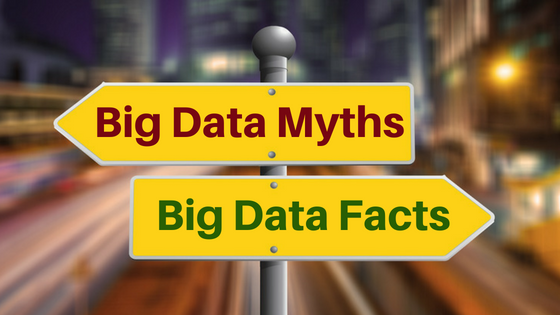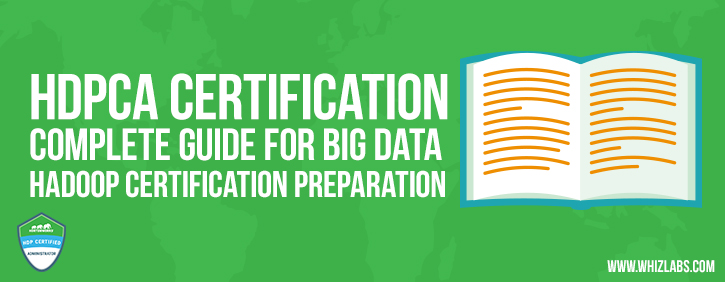Technology and science are observing revolutionary advancements every day and businesses are trying to extract the best out of it. Data analytics is one of such areas where they are utilizing big data and data science at their fingertips to combine the enormous amount of data with business strategies.
Indeed, Big Data holds a reasonable extent of promise for all enterprises irrespective of their sizes. Through Big data analysis, an enterprise can get the insights that help them to not only drive revenue but also understand the gaps in their service and products.
Also Read: Best Big Data Certifications in 2018
Let’s Go Through Most Common Big Data Myths and Facts
Being an evolving technology and relatively a new concept, Big data also carries few myths. But if we don’t evaluate the Big data myths with proper Big data facts, then the incorrect Big data myths can lead to mistakes.
Hence, in this blog, we will discuss the popular Big data myths and the corresponding Big data facts to know the truths. This will help you to tackle these Big data myths and ensure that business works appropriately.
Myth 1: Big data is everywhere
Fact: It is true that at present Big data technologies and services are the centers of attention in the industries with a record high usage. However, Gartner Big data facts and figures show that among all the organizations only 73 percent of organizations are planning and investing in Big data. However, they are still in a budding stage of Big data adoption.
Interestingly, only 13 percent of the surveyed organizations had deployed big data solutions. Gartner big data facts reveal that the main challenges that organizations face are – how to obtain value from Big data with proper strategy.
In addition to that, since it is a complex technology, many organizations find obstacles at the pilot stage as they don’t tie the technology to concrete use cases and business processes.
Myth 2: Big data is all about size
Fact: Big data is characterized by 5V’s – Volume, Velocity, Variety, Veracity, and Value. Though handling a massive amount of data is one of the main features of Big data; however, volume – is merely the prime defining characteristics of Big Data. Furthermore, other features of the data are just as important.
For example, there is a great need for data processing as the data is coming at a rapid rate with a high-speed processing demand. Hence, the faster it will be processed, you will get the more up-to-date and relevant outcome out of it.
Similarly, big data comes in diverse formats. Hence, Variety is another essential feature of Big data which is coupled with challenges and innovative solutions to overcome those challenges.
Hence, Big data must be considered beyond the size of the data, and its speed and diversity should be taken into account. Moreover, if we don’t consider other features with the equal importance, it may turn simple solutions into complicated ones which can incur the cost, storage, and issues in the long run.
New in the world of Big Data? Here is everything you need to know to learn Big Data.
Myth 3: Big data can predict everything about the future of the business
Fact: Analytics can predict the trend using Big data, but it’s not the data which drives the business. A business stands on many factors like economy, human resources, technology and many more. Hence, when it comes to predicting the future of a business, you cannot predict anything certain through data.
Then, what does Big data do for data analysis? Well, prediction through Big data is all about extrapolating what is going to happen in the future comparing the historical data. These historical data shows what has happened in the past. Even if you are analyzing with real-time data, it will be an outcome of some probability theory. Hence, it is not 100% correct. However, the forecasted result will be more accurate if the experimenting data is more and the more it is relevant.
But in reality, the big data fact is that it often fails to predict the correct result even if you use sophisticated statistical analysis. Look at the election polls!
Myth 4: Big Data means big budget and it is for big companies
Fact: It’s true that we have seen organizations like multi-national corporations and governments bodies investing a huge amount to set up large-scale data centers and high-end technologies for implementing Big data. Not only that, employing skilled big data professionals and data scientists is also a very costly affair as their demand is high due to resource crunch in the market.
However, the time has changed. As with its increasing usefulness, vendors like Apache has reduced the licensing cost of Big data tools making them cheaper. Alongside they are bringing up new tools and techniques aiming to help businesses crunch through the collecting data.
Besides that, we must remember that Cloud computing is also enabling Big data technologies and platforms available to the start-ups and smaller organizations at a lower cost. Hence, Big data is becoming affordable to all types of organizations.
Big Data is a broad spectrum. Expand your knowledge of Big Data with these 101 Big Data Terms.
Myth 5: Machine learning concept is related to Big Data
Fact: It is true that machine learning often deals with big data. However, the underlying concept of machine learning is using those data to model the underlying process for better utilization. Moreover, machine learning is solely based on Machine learning algorithms which can parse data sets and then apply what has been learned through it to make meaningful decisions.
Hence, Big and Machine learning in conjunction can provide valuable insights.
Myth 6: There is no need of Data warehouse as Big data in place
Fact: First of all, Data warehouse is an architecture whereas big data is purely a technology. Hence, one cannot replace other technically. A technology, like Big data, stores and manages the enormous scale of data to use them for different Big data solutions at a reasonable low cost.
On the other hand, as a framework data warehouse organizes data to provide a single version of it. It consolidates data from different sources and organizes them in an easily readable way. It also has a capability of data lineage that helps to identify the origin of the data.
Besides that, we know Big Data analysis can be performed without interference from existing data-warehouse implementations and business-analytics.
Hence, data warehouse and Big data have their definite set of needs and applications.
Myth 7: Big Data Technology will eliminate the necessity of Data Integration
Fact: Big data technology uses “schema on read” approach to process information. This enables organizations to use multiple data models for reading the same sources. It is a common thought that it brings the flexibility to allow end users determining how to interpret the data assets on demand. Also, the assumption is that Big data provides the data access tailored to individual users.
However, in reality, users mostly rely on “schema on write” where data is
- Described properly
- Content is prescribed
- There is data integrity along with their relations to the scenarios
Myth 8: Big Data is always quality data
Fact: Big data not necessarily mean it contains clean and quality data. On the contrary, in most of the cases, Big data includes data quality errors. Furthermore, to leverage better and correct insights from collected big data, it is necessary to clean them. Hence, it’s a wrong assumption that there is no need for data cleaning, collecting or analyzing Big data.
Myth 9: Big data is for analytics
Fact: You will get at least 12 different definitions of Big data from various sources. Somewhere it is defined with 5 V’s, somewhere as a massive data sets and somewhere it is intersected with analytics. Hence, everyone has their different approaches towards the definition.
Moreover, Big data is a technology which has many features other than data analysis. Hence, the Big data fact is in many scenarios, it is used to analyze complex use-case patterns to get better insights to solve the problems.
Big Data Analytics is very important for businesses. Let’s understand why is Big Data Analytics so important!
Myth 10: Hadoop is the alternative to in-memory Technology
Fact: Hadoop is the most popular Big data tool. In-memory technology is integrated with Hadoop underlying architecture to help to integrate large volumes of data from various sources in real time. Hence, in-memory is an ideal platform for Hadoop and a technical basis of it.
So, the big data fact here is that Hadoop is not a competitive technology or an alternative to in-memory computing.
Are These Big Data Facts Really Important?
The above mentioned big data facts and big data myths are very obstructive. Moreover, they can lead to bad business decisions. Without validating the big data facts against these myths, a business can waste precious resources, which may have otherwise been used to increase the businesses flexibility.
Bottom Line
To verify the capability of a technology it is best to know it at a deeper level. Hence, if you want to learn Big data, start learning Hadoop, get a big data certification and grow big in your career. Whizlabs leverages the knowledge with Big Data training courses. Our training courses will make you learn the theory and get hands-on expertise on the subject matters.
Join us today and get familiar with big data facts!
Do you know any other myth about Big Data? Write that below in the comment section, we’ll provide an explanation against that.
- Top 45 Fresher Java Interview Questions - March 9, 2023
- 25 Free Practice Questions – GCP Certified Professional Cloud Architect - December 3, 2021
- 30 Free Questions – Google Cloud Certified Digital Leader Certification Exam - November 24, 2021
- 4 Types of Google Cloud Support Options for You - November 23, 2021
- APACHE STORM (2.2.0) – A Complete Guide - November 22, 2021
- Data Mining Vs Big Data – Find out the Best Differences - November 18, 2021
- Understanding MapReduce in Hadoop – Know how to get started - November 15, 2021
- What is Data Visualization? - October 22, 2021

